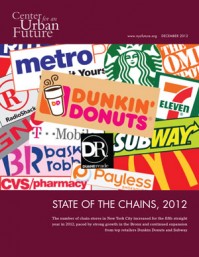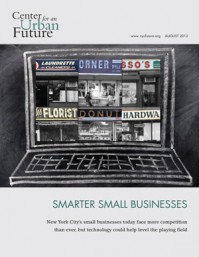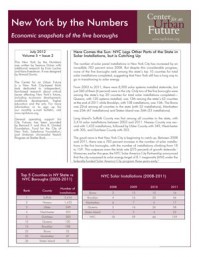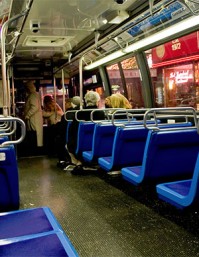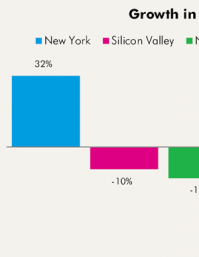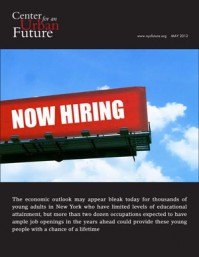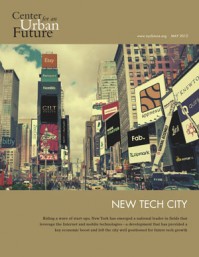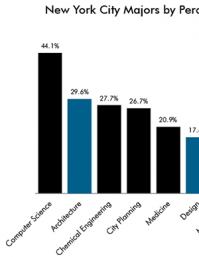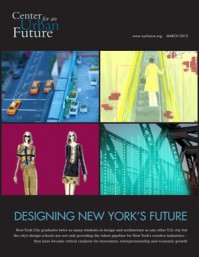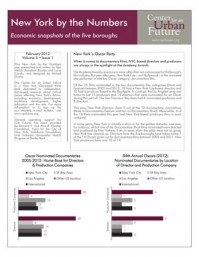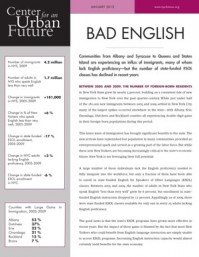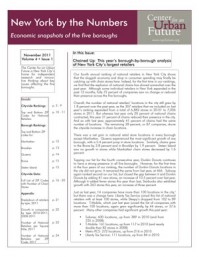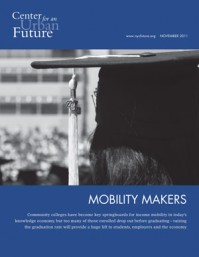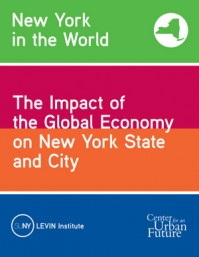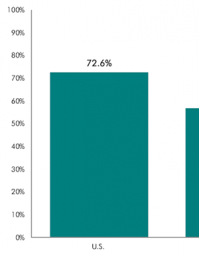Report - December 2012
State of the Chains, 2012Our fifth annual ranking of national retailers in NYC shows that the number of chain stores in New York City increased for the fifth straight year in 2012, paced by strong growth in the Bronx and continued expansion from top retailers Dunkin Donuts and Subway.
Data - August 2012
Data from Smarter Small BusinessesSelected charts and graphs from the Center for an Urban Future's August 2012 report on technology use among NYC's small businesses. The report found that far too many of NYC's small businesses still aren't using websites, online ads and other technology tools, a huge missed opportunity at a time when small firms face increasing competition from national chains and online companies.
Report - August 2012
Smarter Small BusinessesThis report finds that far too many of NYCs small businesses still arent using websites, online ads and other technology tools, a huge missed opportunity at a time when small firms face increasing competition from national chains and online companies.
Report - July 2012
Here Comes the SunThis edition of New York by the Numbers reveals that New York City lags behind the rest of the state when it comes to installing solar energy panels in residential, commercial and government buildings, but is beginning to catch up.
Commentary/Op-Ed - July 2012
GED® change will be costly for N.Y.In July 2012, the Albany Times Union published an op-ed by our senior fellow Tom Hilliard which notes that beginning in 2014 the GED® exam will cost twice as much to take and be significantly more difficult to pass, changes that will almost certainly lead to significantly fewer New Yorkers getting their GED® credential. Already, New York is 49th out of 50 states in the GED® pass rates. In the op-ed, Tom urges New York State education officials and legislators to explore alternatives to the GED® test.
Testimony - June 2012
Keeping Up with the BoroughsThe New York City Council held a hearing that was prompted by the Center for an Urban Future's 2011 "Behind the Curb" report, which documented that New York City's public transit service has not kept pace with recent job growth and transit ridership gains in the Bronx, Brooklyn, Queens and Staten Island. The Center commended the Council's Transportation Committee for convening the hearing, which is titled "Keeping Up with the Boroughs—Addressing Public Transit Needs Outside Manhattan."
Data - May 2012
Data from New Tech CitySelected charts and graphs from the Center for an Urban Future's major May 2012 report on NYC's tech sector. The report found that, riding a wave of start-ups, New York has emerged as a national leader in fields that leverage the Internet and mobile technologies—a development that has provided a key economic boost and left the city well positioned for future tech growth.
Report - May 2012
Now HiringWhile young adults without a college degree are among those who are having the hardest time finding decent paying jobs today, this report provides a ray of hope. It identifies more than two dozen occupations in New York City that are expected to have ample job openings in the years ahead which pay decent salaries and which are accessible to young adults with low levels of educational attainment.
Report - May 2012
New Tech CityRiding a wave of start-ups, New York has emerged as a national leader in fields that leverage the Internet and mobile technologies—a development that has provided a key economic boost and left the city well positioned for future tech growth
Testimony - April 2012
The Economic Impact of NYC’s LibrariesAt a City Council hearing on the city's proposed $100 million budget cut to public libraries, CUF's David Giles testified on the growing importance of branch libraries as community centers. At a time when the city faces enormous human capital challenges, more and more New Yorkers depend on the public libraries for job information, resume writing help, adult literacy, English language classes and other key services.
Data - March 2012
Data from Designing New York’s FutureSelected charts and graphs from the Center for an Urban Future's March 2012 report on NYC's design schools. The report found that New York City graduates twice as many students in design and architecture as any other U.S. city, but the city's design schools are not only providing the talent pipeline for New York's creative industries—they have become critical catalysts for innovation, entrepreneurship and economic growth.
Report - March 2012
Designing New York’s FutureNew York City graduates twice as many students in design and architecture as any other U.S. city, but the city's design schools are not only providing the talent pipeline for New York's creative industries—they have become critical catalysts for innovation, entrepreneurship and economic growth.
Report - February 2012
New York’s Oscar PartyThis edition of New York by the Numbers reveals that when it comes to documentary films, NYC-based directors and producers are always in the spotlight at the Academy Awards.
Data - January 2012
Data from Bad EnglishSelected charts and graphs from the Center for an Urban Future's January 2012 policy brief which found that communities from Albany and Syracuse to Queens and Staten Island are experiencing an influx of immigrants, many of whom lack English proficiency—but the number of state-funded ESOL classes has declined in recent years.
Report - January 2012
Bad EnglishCommunities from Albany and Syracuse to Queens and Staten Island are experiencing an influx of immigrants, many of whom lack English proficiency—but the number of state-funded ESOL classes has declined in recent years.
Data - November 2011
Data from Mobility MakersSelected charts and graphs from the Center for an Urban Future's November 2011 report on NYC's community colleges. The report found that community colleges are crucial platforms for economic mobility in today's knowledge economy, but showed that too few of those enrolled in these institutions actually graduate.
Report - November 2011
Chained UpOur fourth annual ranking of national retailers in NYC shows that the growth of chain stores has slowed over the past year. While the number of chain stores is up by 1.6 percent over last year, more retailers reduced their presence in the city than expanded. And though Dunkin Donuts tops our list again, for the first time it did not have a net gain in stores.
Report - November 2011
Mobility MakersThis report finds that community colleges are crucial platforms for economic mobility in today's knowledge economy, but shows that too few of those enrolled in these institutions actually graduate.
Report - October 2011
New York in the WorldNew York in the World: This new report jointly issued by the Center for an Urban Future and the SUNY Levin Institute provides the first comprehensive impact of how globalization has impacted NYC and NYS. It finds that no state has benefited more and suffered worse from globalization than New York.
Data - September 2011
Data from Failing the TestSelected charts and graphs from the Center for an Urban Future's September 2011 report which examined several options for improving the GED system: whether New York should charge a fee for test takers, the benefits and costs of the official practice test, availability and quality of preparatory instruction and providing a bridge from GED to postsecondary education and training.

